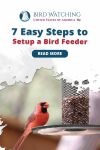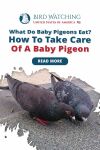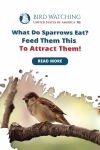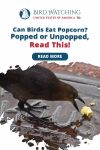
What’s This Post About?
Bird feeders are a great way of attracting birds to your backyard. The process can be quite complicated if not done right. This post will explain how you can install a bird feeder in 7 easy steps.
The purpose of putting up a bird feeder is to enhance the overall appearance of your home and to make it look more aesthetic and welcoming. It allows you to take a break from mundane tasks to relax and appreciate the beauty of nature.
To set up a bird feeder, you need to find the ideal location of where you wish to set it up, decide on which birds you wish to attract, choose the type of feed you want to fill it with, decide on its placement whether it is to be hung or manually installed and go ahead with your purchase.
How To Set up A Bird Feeder?
Setting up a feeder can be a confusing process at first but by understanding and reading each of the steps we have covered below, it will become much easier and straightforward for you. Once done properly, it is extremely rewarding and the effort is completely worth it.
Here are the 7 simple steps you can follow to help you set up a bird feeder:
- Find the Ideal Location
- Decide which birds you’re looking to attract
- Choose the food you want to keep in the bird feeder
- Decide how you want your bird feeder to be set up
- Purchase the Feeder
- Add Water
- Eliminate Unwanted Animals
If you don’t know which feeder to get, we have a recommendation! You can purchase a basic hummingbird feeder from Amazon.
MEKKAPRO Outdoor Hummingbird Feeder
With its beautiful color and design, it’s easy to say it’s the best and most charming feeder there is.
1. Find the Ideal Location

You can place the bird feeder anywhere in your yard. You can attach it to bushes, trees, or even fences. However, to attract the maximum amount of birds, the feeder should be installed somewhere the birds feel safe.
Some things you should consider when deciding a location include:
- Safety from Predators
Cats and hawks are some predators that can make birds feel threatened and prevent them from regularly visiting your feeder.
Cats often hide in bushes or small areas waiting to attack their prey. To avoid this, the bird feeder should be put at a distance from any possible hiding space.

Hawks on the other hand are more difficult to stop. They can be long-staying unwelcome guests. They can hunt birds so you might have to stop your feeding until they leave. One preventative measure that can be taken is by placing the feeder at a higher point so that the birds find it easier to escape.
- Distance from the House
Generally, bird feeders should be set up within 3 feet of a window or more than 10 feet away.
If the feeder is near the window, to begin with, the bird will go at a slower pace knowing that it needs to stop before crashing.
On the contrary, a feeder placed far away from a window will give the birds plenty of space to move around, allowing them to see all the obstacles in its way.
- Viewing Pleasure
You should be able to see and admire the birds in your backyard that have been brought there as a result of your feeder. Hence, you should place it somewhere you can easily see from your window.
2. Decide Which Birds You’re Looking to Attract

Once you decide the type of birds you want to attract, you can buy the food and feeder. This is because different food attracts different species of birds and you buy the feeder according to the food. You need to research the type of birds you have in your area and buy supplies accordingly.
Water however is the one thing that lures all kinds of birds. Especially in the summers when the humidity is high, various birds will come to your feeder to quench their thirst.
If you want to learn more about bird baths, our awesome post about installing bird baths!
5 Easy Steps to Install a Bird Bath: Security, Position, Height, and More Tips!
Install a birdbath today and make your lawn, a bird’s gorgeous looking, favorite rest spot. Read more about this garden accessory now!
3. Choose The Food You Want to Keep in The Bird Feeder

As mentioned earlier, the type of food you want varies according to the birds. Meaning that you will have to research the type of food you require. Food choices can differ over a large range.
Seeds, nectar, black-oil sunflower, peanuts, bugs, and suet are some foods you can put in your feeder. Try to avoid cheap alternatives which the majority of the bird don’t even eat.
Warning
Some cheap options that you should avoid include milo, wheat, and oats. Very few birds eat these which will eventually make it a waste of money and resources to buy them.
4. Decide How You Want Your Bird Feeder To Be Set Up

Depending on the type of bird feeder you want, you can determine how you want to mount it. The most common method used to set up a bird feeder is by attaching it to a sturdy pole.
However, different methods can be followed depending on which tools you have at your disposal and what you want your backyard to look like.
Besides poles other mounting methods are:
- Shepherd’s Hook
A shepherd’s hook can be placed anywhere on your lawn. It needs to be inserted properly into the ground so that it remains steady and the feeder is placed onto its hook. The feeder should be a lightweight one as it hangs from the hook.
- Post Mount Feeder
It is a small wooden platform with a tiny shed made on top of it. The food is placed on the wood and then the feeder is either put onto a fence or post.
- Deck Mount Brackets
This feeder hangs on a pole attached to your deck railing.
5. Purchase the Feeder

By doing your research and following the first four steps, you can now finally buy your feeder. You need to consider several variables such as the type, size, and accessibility of the bird feeder.
You want a feeder that is open and can be easily used by the birds but not open enough to make it vulnerable to squirrel attacks. Here are some that you can explore.
- Hopper or “House” Feeders
Hopper feeders can be hung by a hook or mounted on a pole. They are quite convenient as it is spacious and can hold enough food to last a few days. It is durable against the weather and bird droppings, but if it does get wet, it can harbor bacteria and fungus.
- Window Feeders
These are high-maintenance plastic cups that are fixed on windows by suction cups. They make it easier for you to see the birds as you get a close-up view from the window.
- Suet Feeders
Suet feeders are made of wire mesh. They are usually nailed to a tree trunk and attract a variety of woodpeckers, nuthatches, chickadees, titmice, jays, and starlings.
- Question: What should I do with my feeder during a storm or extremely windy weather?
To avoid damaging your feeder take it down during bad weather conditions. This is because rainwater can contaminate the food and also because strong winds can break it.
6. Add Water

Only specific birds come to your feeder depending on the food you’re providing, but one thing all birds have in common is that they all require water. Having a fresh and constant water source is a vital part of your feeder.
Freshwater sources such as birdbaths are very important for your birds as this will not only assist in welcoming different species but will also make birds visit your feeder more regularly.
- Question: How should I clean the birdbath?
Make a solution of one part distilled vinegar and nine parts water. Scrub your birdbath with a brush after using this solution.
Useful Tip!
The birdbath needs to be scrubbed and cleaned and the water needs to be replaced daily otherwise it becomes a breeding ground for bacteria.
7. Eliminate Unwanted Animals

Unwanted animals such as squirrels and house sparrows can prove to be quite problematic. While squirrels eat up all your food and drive birds away, house sparrows hoard the feeding station and leave no space for other birds.
You should be able to catch all of these issues early on so that you can eliminate them as quickly as possible. Keeping a keen eye on your feeder will help you figure out any abnormalities.
Keep Reading!
To set up the bird feeder, find the ideal location to place the feeder. Decide the birds you want to attract and set up an appropriate feeder with food that those birds like. Place it at a point which is away from unwanted animals like squirrels.
Remember to follow all the steps in order and ensure that your birds are well taken care of. After all, the birds’ safety and well-being are of the utmost priority. Once everything is in place, you are now ready for bird watching once these beautiful birds visit your yard.
Read our blog on how to start birdwatching for an enthralling experience.
How to Start Bird Watching? A Fantastic Guide for An Enthralling Experience!
Is the trend of birdwatching catching onto you? Are you looking to amplify your birdwatching experience? Don’t miss out on reading this fantastic guide.

By David A. Swanson
Bird Watching USA
My name is David and I'm the the founder of Bird Watching USA! I started Bird Watching with My father-in-law many years ago, and I've become an addict to watching these beautiful creatures. I've learnt so much over about bird watching over the years that I want to share with the world everything I know about them!

David A. Swanson
Bird Watching USA
My name is David and I'm the the founder of Bird Watching USA! I started Bird Watching with My father-in-law many years ago, and I've become an addict to watching these beautiful creatures. I've learnt so much over about bird watching over the years that I want to share with the world everything I know about them!











